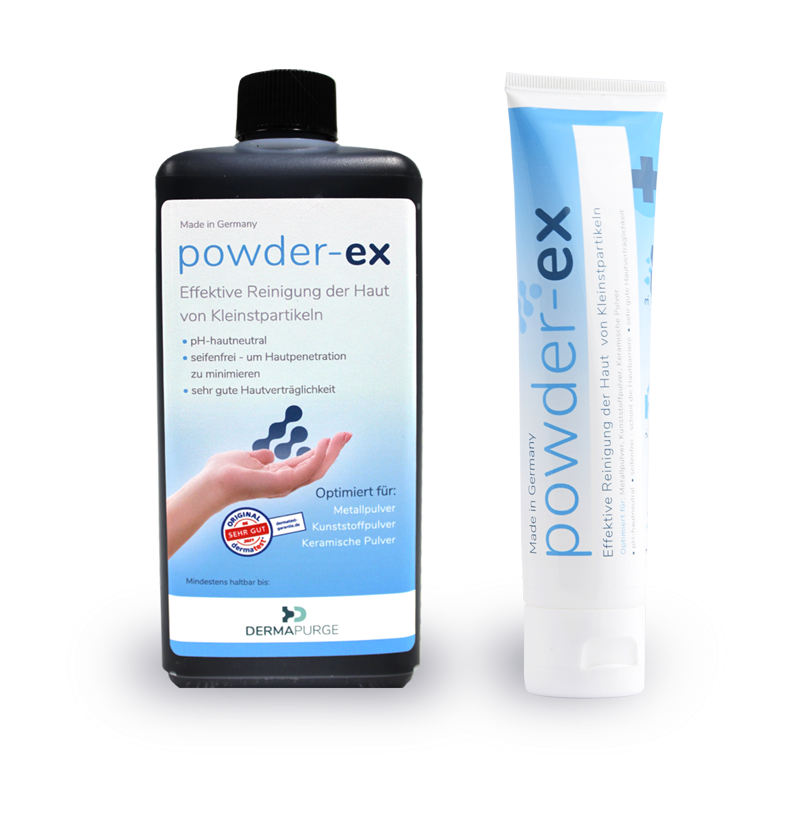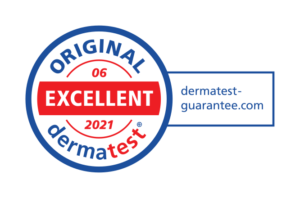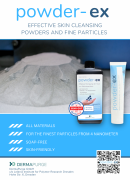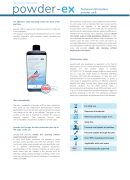powder-ex
daily skin cleansing - optimal against powder materials and finest particles
powder-ex is optimised for daily use in the workplace for effective and gentle skin cleansing of powdery materials, especially metal, plastic and ceramic powders. powder-ex removes even the smallest particles from the skin without affecting the skin barrier – a great advantage in daily use compared to soaps and detergents with friction bodies.

References














Removes all materials
powder-ex is universally applicable: it removes metal, semiconductor, polymer and inorganic particles.
For the smallest particles from 4 nanometres
The smaller the particle size, the more difficult it is to remove them from the skin with water alone. powder-ex removes even the smallest particles from a size of 4 nanometres.


High Performance
powder-ex is specially designed to bind the smallest particles in order to remove them from the skin: even nanoscale particles are removed by more than 99 %.
soap-free
In order not to impair the natural skin barrier when cleaning the skin of hazardous substances, powder-ex was developed completely without soaps and penetration enhancers – in accordance with the recommendation of HSE guidelines like the German ‘TRGS 401’.


Dermatologically tested
powder-ex is pH skin neutral and very well tolerated by the skin. The skin compatibility has been tested by the independent dermatest institute and rated as ‘excellent’.
Complements the skin protection plan
powder-ex complements soap in the skin protection plan: Soap is recommended after going to the toilet – but soap should not be used for skin cleansing in the manufacturing environment. powder-ex is used when leaving the premises where powdered materials are stored or processed – for example before a meal break.

Handling powders and fine particles - a challenge for HSE
In many work areas, employees are exposed to metal powders, plastic powders and other fine powders. These can be work areas where powders are used specifically, such as in additive manufacturing, pigment production, compounding or in the cosmetics industry, as well as work areas where they are produced in processes, such as polishing, milling, drilling, blasting or sintering. These work areas are confronted with special challenges in occupational safety. Small particles in particular cannot usually be removed from the skin using standard methods. Both skin contact and the resulting oral ingestion of the particles through contamination carry-over pose a health risk.
The smaller the particle size, the less suitable existing agents are for washing off the powders. Skin cleansing agents used should not contain soaps or other penetration enhancers in order not to damage the natural skin barrier. Soap, surfactants and solvents open the pores of the skin, which can lead to an increased absorption of hazardous substances (see German Guidelines TRGS 401).
powder-ex was developed to meet the high requirements in these work areas: Reliable skin cleansing without impairing the skin barrier.
Frequently Asked Questions (FAQ)
Work areas where fine powders are used or fine particles are generated in the process, as is the case in numerous industries – for example, additive manufacturing and post-processing of components, metalworking, surface treatment, pigment production or compounding.
powder-ex is implemented both as regular skin cleansing in the skin protection plan or as an effective aftercare solution (for example in the case of torn gloves).
An underestimated uptake pathway for very small particles is oral uptake through contamination carry-over. Every person touches his or her face about 400-800 times a day, the majority to the eyes, nose and mouth. Of all the particles that land near the oral cavity, about 40% end up in the mouth. This topic has so far been underrepresented in occupational safety and is all the more important when particles are difficult to remove from the skin.
- Study on oral intake in lead workers: Cherrie 2006: https://academic.oup.com/annweh/article/50/7/693/318136
- E.g. see the study of the German federal institute for Risk Assessment Christo 2021: https://www.mdpi.com/2079-4991/11/10/2623
- Study on hand-mouth-contact and contamination carry-over Mueller 2019: https://journals.plos.org/plosone/article?id=10.1371/journal.pone.0213677
Small particles below 20 μm cannot be seen with the naked eye. Some of the particles are smaller than a hundredth of a hair and are very difficult to remove from the skin. As a rule of thumb, the smaller the particles and the more hydrophobic, the less effective water and soap are.
- e.g. Lewinski 2017: https://www.tandfonline.com/doi/abs/10.1080/15459624.2017.1296238
Soap, surfactants and solvents weaken the natural skin barrier and flush sebum out of the skin pores. This makes it both easier for hazardous substances to penetrate the skin and easier for them to penetrate through pores. This ‘wash-in effect’ has been known since the 1990s. This has already found its way into the BAuA guidelines (TRGS401).
- German Technical rules for hazardous substances / Technische Regeln für Gefahrstoffe 401: § 4.1: (6): https://www.baua.de/DE/Angebote/Rechtstexte-und-Technische-Regeln/Regelwerk/TRGS/TRGS-401.html
- Wash-in-effect: R. P. Moody et al., Journal of Dermatological Science 9,1995, 48-58.
- Current overview: James 2022: https://www.ncbi.nlm.nih.gov/pmc/articles/PMC8903816/
For complementary pre-work skin protection, care should be taken not to use creams that compromise the skin barrier. Many prophylactic skin creams contain penetration enhancers. This makes it easier for hazardous substances to penetrate the skin. Even barrier creams without penetration enhancers do not provide perfect protection, as this is reduced over time by perspiration and the wearing of PPE.
- Only skin protection products should be used that have confirmed their effectiveness according to the guideline of the Arbeitsgemeinschaft für Berufs- und Umweltdermatologie (ABD): “Occupational skin products”. Only very few barrier creams comply with the guidelines. Please do not hesitate to contact us if you have any questions. TRGS401, 6.4.4. point 3, https://www.baua.de/DE/Angebote/Rechtstexte-und-Technische-Regeln/Regelwerk/TRGS/pdf/TRGS-401.pdf?__blob=publicationFile
powder-ex is implemented both as regular skin cleansing in the skin protection plan or – if contamination due to preventive measures only occurs in exceptional cases – as an effective aftercare solution (for example in the case of torn gloves).
As a regular skin cleanser, powder-ex complements soap. While soap is useful after going to the toilet, for example, soap should not be used for skin cleansing in the manufacturing environment. powder-ex is used when leaving the premises where powdered materials are stored or processed – for example, before a meal break.
Small particles that are difficult for the body to break down or eliminate (e.g. many metals, plastics and mineral substances) accumulate in organs and lymph glands. In addition, there is a danger that they will penetrate the blood vessels and cause internal bleeding. In the long term, there is a risk of organ damage, reduced fertility, oxidative stress, inflammation and cancer. This also applies to materials that are not classified as carcinogenic, as a decisive factor for accumulation is the size of the particles themselves.
- Overview of the uptake and hazards of microplastics/nanoplastics by the Royal Society of Chemistry: Abdallah 2022: https://pubs.rsc.org/en/content/articlehtml/2022/em/d1em00301a
- As an example of metal particles (similar powders are used in many industries): GizChem data sheet of the BGRCI/BGHM on additive manufacturing with metal powders: https://www.gischem.de/download/01_604106-00_7_1_3980.PDF
As a medium-term consequence of frequent skin contact with particles, skin irritations, allergies and skin diseases may occur. The danger increases when the skin is frequently washed with soap. The skin barrier is weakened, the skin becomes vulnerable and micro-particles thus find it easier to penetrate the pores.
- See GizChem Datasheet of the German employers’ liability insurance associations BGRCI/BGHM on additive manufacturing with metal powders: https://www.gischem.de/download/01_604106-00_7_1_3980.PDF
Hand washing pastes usually contain abrasive bodies. These damage the skin barrier in addition to the soaps, surfactants and penetration enhancers they contain. In addition, small injuries can occur in the skin. Thus, hazardous substances enter directly into the bloodstream.
Hand brushes should be avoided at all costs when working with very small particles.
- Study by the German Social Accident Insurance DGUV: https://www.dguv.de/medien/ipa/publikationen/ipa-journale/ipa-journale2021/ipa-journal2103/ipa-journal2103_handreiniger.pdf
The size distribution of particles in mineral, metal and plastic powders given by the manufacturer is often misleading for occupational safety. It reflects the volume average of particles. Since small particles have much less volume than larger ones, they play a subordinate role in the calculation. For occupational safety with powders, however, it is precisely these particles that are important.
In addition, fine particles in the nanoscale range are often produced during transport and use due to abrasion.
- Since micro- or satellite particles below 20 μm have a comparably low volume, they appear underrepresented, although the sheer quantity can far exceed the quantity of larger particles. On the size distribution and satellite particles in powders in additive manufacturing: (similar powders are used in many industries) Seyda 2018: https://link.springer.com/chapter/10.1007/978-3-662-58233-6_6
- On request, DermaPurge’s own SEM image material on commercial PT12, titanium, chromium, nickel, aluminium-magnesium, steel, copper and chips from common milling machines, saws and rotating grinders, which have a similar size distribution to new powders.
Hand protection is an important component of occupational safety with very small particles, but it is not sufficient. Only chemical protective gloves (e.g. nitrile) protect against particles smaller than 20 μm. In gloves worn primarily to protect against mechanical impact, particles pass through the fabric.
However, the use of chemical protective gloves is not without problems:
- Chemical protective gloves are thin and often tear when worn too long or when working with metal.
- Prolonged wear leads to increased perspiration, which strongly promotes the absorption of particles and can trigger skin irritations and allergies.
- Careless donning and doffing of gloves often leads to skin contact with particles.
- See for example GizChem data sheet of the BGRCI/BGHM on additive manufacturing with metal powders (similar powders are used in many industries): https://www.gischem.de/download/01_604106-00_7_1_3980.PDF
- On the wearing time of gloves and resulting health risks see also: https://link.springer.com/article/10.1007/s00735-022-1554-3
- TRGS401: https://www.baua.de/DE/Angebote/Rechtstexte-und-Technische-Regeln/Regelwerk/TRGS/pdf/TRGS-401.pdf?__blob=publicationFile
Full protection is an important component in occupational safety with very small particles. To be noted:
- Studies have shown that contamination is still present at the transition points between PPE (wrists, ankles, face, neck, abdomen if applicable).
- Prolonged wearing leads to increased perspiration, which favours the absorption of particles.
- Careless donning and doffing of the full protective suit often leads to skin contact with particles.
- Type 5 suits according to DIN EN ISO 13982-2 may be permeable to up to 15% of particles.
- On the permeability of full face protection: Jennifer L. A. Keir; et.al., Elevated Exposures to Polycyclic Aromatic Hydrocarbons and Other Organic Mutagens in Ottawa Firefighters Participating in Emergency, On-Shift Fire Suppression. Sci. Technol. 2017, 51, 21.
- DIN/ISO standard: https://www.din.de/de/mitwirken/normenausschuesse/nps/veroeffentlichungen/wdc-beuth:din21:66396910
The maximum values for particle exposure specified by the BG refer to the inhalation of particles or alveolar permeability and play only a secondary role for the oral uptake of particles. There are currently no maximum values either for exposure to nanoparticles in the air or for general particle exposure on the skin. For this reason and the proven hazard situation, the precautionary principle applies.
- For nanoparticles in general, TRGS 527 applies: Currently, there are no substance-specific occupational exposure limits for substances in nanoform in Germany.
- Particle load in air is expressed in volume per cubic metre and is not meaningful if particles are smaller than 20 μm.
- In TRGS 401 (skin) and TRGS 900 (limit values), no limit values are specified for particle exposure on the skin.














